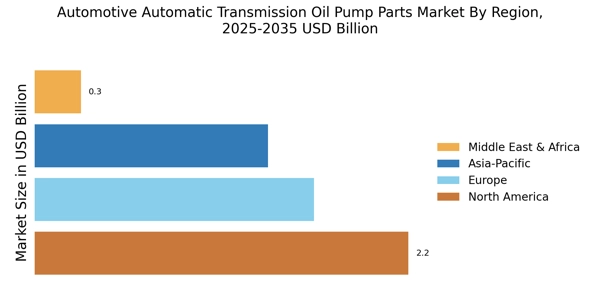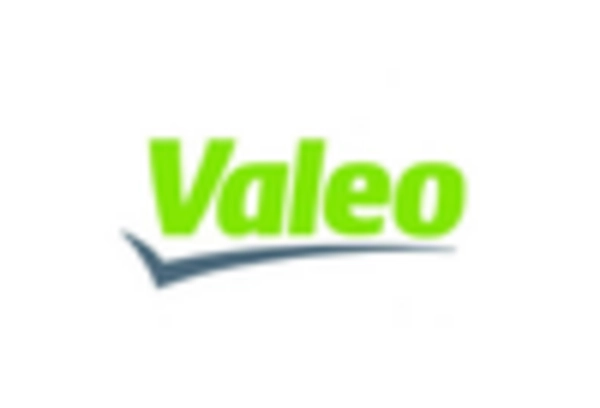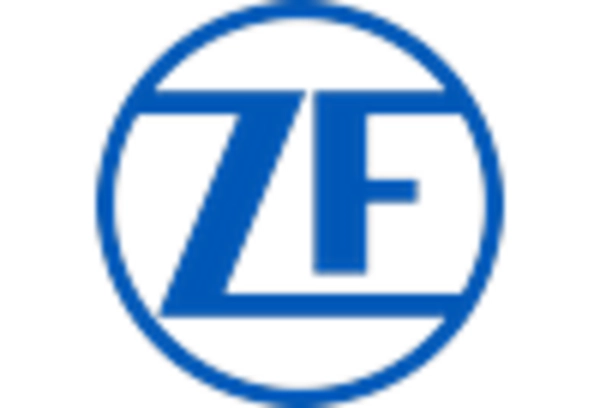The Automotive Automatic Transmission Oil Pump Parts Market is characterized by a dynamic competitive landscape, driven by technological advancements and increasing demand for efficient transmission systems. Key players such as Aisin Seiki Co., Ltd. (Japan), BorgWarner Inc. (US), and ZF Friedrichshafen AG (Germany) are at the forefront, each adopting distinct strategies to enhance their market positioning. Aisin Seiki Co., Ltd. focuses on innovation in hydraulic systems, aiming to improve fuel efficiency and reduce emissions. BorgWarner Inc. emphasizes its commitment to electrification and hybrid technologies, aligning its product offerings with the growing trend towards sustainable automotive solutions. ZF Friedrichshafen AG, on the other hand, is investing heavily in digital transformation, integrating advanced software solutions into its transmission systems to enhance performance and reliability. Collectively, these strategies not only bolster their competitive edge but also shape the overall market dynamics, fostering an environment where innovation is paramount.
In terms of business tactics, companies are increasingly localizing manufacturing to reduce costs and enhance supply chain efficiency. This approach is particularly evident in regions with burgeoning automotive markets, where proximity to customers can lead to faster response times and improved service levels. The market structure appears moderately fragmented, with several key players holding substantial market shares while numerous smaller firms contribute to niche segments. The collective influence of these major players is significant, as they set industry standards and drive technological advancements that smaller competitors often follow.
In August 2025, Aisin Seiki Co., Ltd. (Japan) announced a strategic partnership with a leading electric vehicle manufacturer to develop next-generation transmission systems tailored for electric drivetrains. This collaboration is poised to enhance Aisin's capabilities in the rapidly evolving electric vehicle segment, positioning the company as a key player in the transition towards electrification. The strategic importance of this partnership lies in its potential to leverage Aisin's expertise in hydraulic systems while addressing the unique challenges posed by electric vehicle architectures.
In September 2025, BorgWarner Inc. (US) unveiled a new line of high-efficiency oil pumps designed specifically for hybrid vehicles. This launch reflects BorgWarner's strategic focus on sustainability and its commitment to meeting the demands of an increasingly eco-conscious consumer base. By expanding its product portfolio to include solutions for hybrid applications, BorgWarner not only strengthens its market position but also aligns itself with the broader industry shift towards greener technologies.
In October 2025, ZF Friedrichshafen AG (Germany) revealed its plans to invest in AI-driven analytics for its transmission systems. This initiative aims to enhance predictive maintenance capabilities, thereby improving the reliability and performance of their products. The strategic significance of this move lies in ZF's ability to harness data analytics to optimize operational efficiency, which could lead to reduced downtime and increased customer satisfaction. As the automotive industry continues to embrace digitalization, ZF's proactive approach positions it favorably in a competitive landscape increasingly defined by technological integration.
As of October 2025, current competitive trends indicate a pronounced shift towards digitalization, sustainability, and AI integration within the Automotive Automatic Transmission Oil Pump Parts Market. Strategic alliances are becoming increasingly vital, as companies seek to pool resources and expertise to navigate the complexities of modern automotive demands. Looking ahead, competitive differentiation is likely to evolve from traditional price-based competition to a focus on innovation, advanced technology, and supply chain reliability. This transition underscores the necessity for companies to adapt swiftly to changing market conditions and consumer preferences, ensuring they remain relevant in an ever-evolving landscape.


















Leave a Comment